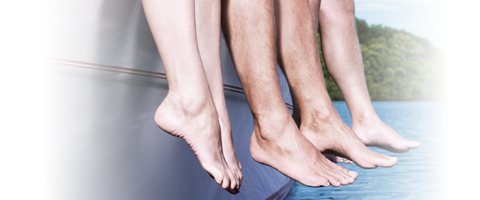What you should do when travelling with varicose veins
Here you will find detailed information

Travelling with varicose veins
According to the Bonn Vein Study, 30% of adults suffer from pronounced varicose disease. Swellings and an increased risk of thrombosis are the results. Here we give you some ideas as to how you can minimise the risks on long train, bus or car journeys, and long-haul flights.
Anyone who already has varicose veins or suffered a thrombosis in the past should plan their journey carefully and discuss the issues with a doctor beforehand. The doctor may prescribe compression stockings to prevent thrombosis. In addition, it is worth thinking out a strategy at home for how to move about as much as possible on your journey. For example, if the aircraft has reached its cruising height and there is no turbulence, the aisle between the seats offers some space for movement. You can also perform some of the vein exercises. This will stimulate the circulation – not to mention that the time will pass quicker.
Pay attention to the following:
- Choose comfortable loose-fitting clothing for the journey and avoid wearing tight belts, tights, and trousers with narrow waistbands, and constricting cuffs.
- Wear comfortable shoes without high heels. It is best to wear trainers or other sports shoes for the vein exercises.
- If you have support or compression stockings, wear them during the journey to support your veins and improve the blood flow.
- Move as much as possible – especially your feet and legs. Whenever possible walk along the aisle of the plane or the corridor on the train. You can do at least a few vein exercises standing (train, plane) or sitting (train, plane, car, bus, or coach). It is a good idea to print out the vein training exercises beforehand and decide which ones you will be able to do on your journey.
- Request an aisle seat on the plane or bus, so that you can stretch your legs out comfortably and make it easier to perform the vein exercises.
- Whenever possible, break your journey several times for 30 minutes and use your legs during these stops.
- If you can, put your feet up and change your body position frequently.
- Make sure that you drink enough fluids when travelling, even if this means you have to go to the toilet more frequently. This is particularly important on flights, as the extremely dry air in the cabin soon dries out the body and makes the blood thicker. Make sure you take enough fluids with you on your journey.
- Do not drink alcohol, as this tends to dilate the veins and may additionally slow down the circulation.
- Eat only light meals and put the cigarettes away for the duration of the journey.
- Try not to sleep for long periods in a sitting position with the knees bent, as this increases the risk of thrombosis.
- Avoid taking sedatives or sleeping pills, as sitting still without moving around increases the tendency to thrombosis.
These tips and tricks should make sure that nothing stands between you and your journey.
